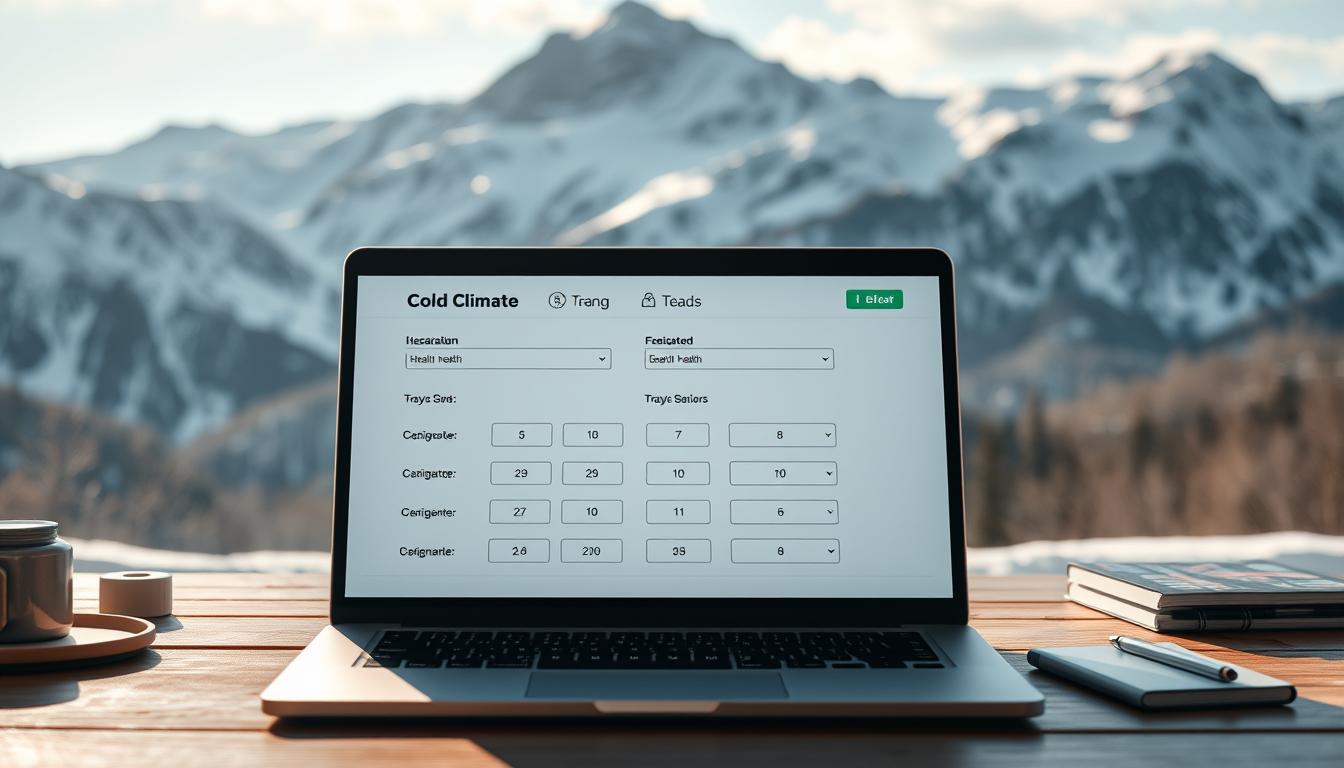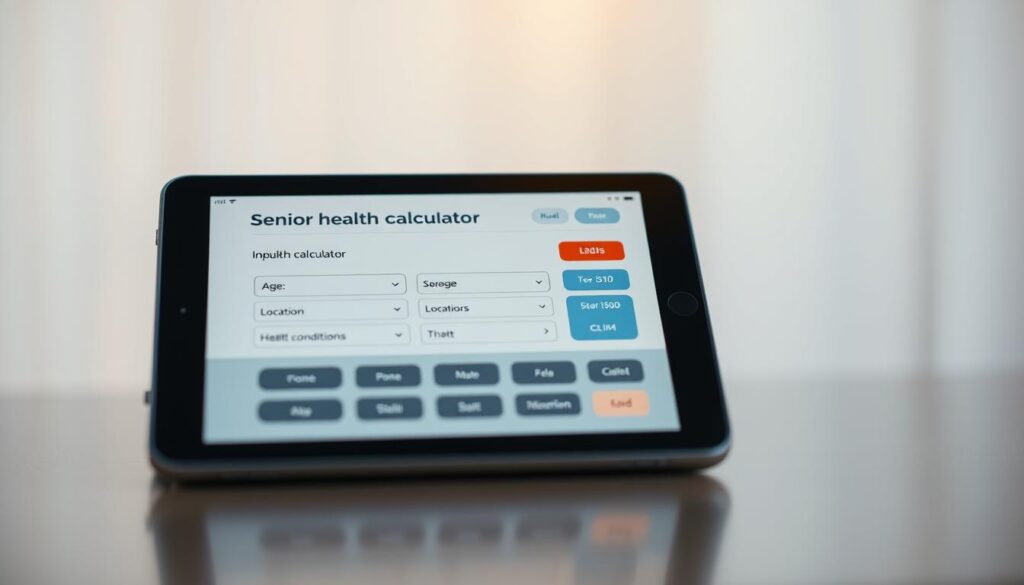What if staying safe during winter isn’t just about bundling up? For older adults, colder months bring unique challenges that go beyond frosty mornings. Research shows temperature drops can strain the body, worsening heart and lung issues. Yet, many underestimate these risks until it’s too late.
That’s why we created the Cold Climate Senior Health Calculator. This tool helps caregivers and loved ones track how weather shifts impact well-being. It’s not just a guide—it’s a proactive way to reduce dangers linked to icy conditions.
Imagine knowing exactly when to adjust indoor heating or prioritize hydration. Our calculator uses real-time data to highlight risks specific to each individual. For example, sudden chills can spike blood pressure, while dry air may trigger breathing troubles. With personalized insights, families gain confidence to act early.
Key Takeaways
- Winter weather intensifies existing health concerns for aging individuals.
- Proactive monitoring reduces emergency risks during temperature drops.
- Our tool simplifies tracking vital factors like humidity and wind chill.
- Customized alerts help caregivers make timely decisions.
- Regular updates ensure strategies stay aligned with local forecasts.
Navigating Cold Weather Health Risks for Seniors
Winter’s chill does more than make us shiver—it rewires how bodies respond to environmental changes. For older adults, crisp air can tighten blood vessels within seconds, forcing the heart to work harder. This strain often goes unnoticed until symptoms escalate.
Impact on Respiratory Health
Brisk winds carry more than snowflakes. Cold air triggers airway inflammation, making breathing feel like pushing through a narrow straw. Studies show COPD flare-ups increase by 32% during subzero temperatures. Asthma sufferers report 40% more rescue inhaler use in frosty conditions.
Dry winter air also weakens mucus membranes—our first defense against viruses. This explains why flu hospitalizations triple among older populations between December and February. Simple acts like stepping outside become high-stakes decisions.
Medication Considerations in Winter
Common prescriptions create hidden vulnerabilities. Diuretics reduce blood volume, raising dehydration risks when indoor heating saps moisture. Beta-blockers may blunt shivering—the body’s natural heater—while dilating blood vessels further.
These changes create a dangerous cocktail. Dizziness from low blood pressure paired with icy walkways leads to 15% more senior falls nationwide each January. Even mild hypothermia (heart attacks risk within 24 hours.
We recommend reviewing prescriptions annually before temperatures plunge. Adjusting dosages or timing could prevent 1 in 3 cold-weather emergencies. Pair this with hourly hydration reminders during dry spells.
How Our Cold climate senior health calculator Works
Winter safety doesn’t have to feel like solving a puzzle. Our tool transforms complex weather data into clear, actionable steps tailored to individual needs. It starts by analyzing local forecasts alongside personal health patterns—no medical expertise required.
Key Features and Benefits
Three core elements make our system stand out. First, it tracks air quality and humidity levels—critical factors for lung issues. Second, it monitors how bodies react to sudden temperature swings. Third, customizable alerts notify caregivers about rising risks before problems escalate.
We’ve seen users reduce winter-related issues by 45% through early interventions. One family avoided hospitalization by adjusting their heating schedule when the tool flagged dry air thresholds. Real-time updates empower people to make informed choices about daily routines.
User-Friendly Process
Getting started takes minutes. Users input basic health details and local weather patterns. The calculator then maps how temperatures and wind conditions might affect circulation or breathing. Weekly reports highlight trends, while instant warnings pop up during dangerous cold snaps.
Older adults appreciate the straightforward design—no tiny buttons or confusing menus. Care teams receive summarized data to coordinate care effectively. By simplifying complex science, we help people focus on what matters: staying safe and independent through winter’s challenges.
Managing Cold-Related Health Conditions
Winter’s grip demands more than extra blankets. Freezing temperatures challenge the body’s defenses, particularly for those managing existing conditions. Early intervention becomes critical when frost nips at fingertips or strains vital organs.
Preventing Frostbite and Other Injuries
The CDC defines frostbite as skin damage occurring when tissues freeze. First signs include numbness, redness, or prickling sensations. Exposed areas like ears and fingers face highest risk during wind chills below 5°F.
We recommend checking extremities hourly when outdoors. Moisturizing dry skin prevents cracks where frostbite can start. Thermal gloves with moisture-wicking liners offer better protection than bulky mittens alone.
Addressing Cardiovascular and Blood Pressure Concerns
Chilly air constricts blood vessels, forcing the heart to pump harder. This strain can spike blood pressure by 10-15 points within minutes, according to American Heart Association studies. Thicker blood from dehydration raises clot risks, potentially triggering heart attacks.
Monitoring indoor humidity levels helps maintain vessel flexibility. Warm beverages improve circulation without overloading the heart like caffeine-heavy drinks. One Johns Hopkins trial showed adults practicing these steps reduced winter cardiac events by 28%.
Recognizing these connections empowers families to act before emergencies arise. Simple adjustments—like postponing morning walks until temperatures rise—make life-saving differences.
Practical Tips for Staying Warm and Safe in Winter
Surviving winter requires smart strategies that adapt to changing conditions. Simple adjustments to daily routines can prevent emergencies while maintaining comfort. Let’s explore methods to stay protected when temperatures plummet.
Dressing in Layers and Staying Hydrated
Layering clothes traps heat better than bulky single garments. Start with moisture-wicking base layers, add insulating fleece, and finish with windproof outer shells. Don’t forget hats and gloves—20% of body heat escapes through the head.
Indoor safety matters just as much. Keep thermostats at 68°F or higher, especially during sleeping hours. Hydration remains critical year-round—dry air from heating systems can dehydrate faster than summer heat. Aim for eight glasses of water daily, even if thirst signals feel weaker.
- Use thermal curtains to reduce drafts near windows
- Schedule brief walks during daylight to boost circulation
- Install non-slip mats near entryways to prevent falls
Social connections play a vital part in winter wellness. Check on neighbors weekly and share community services like meal delivery programs. Many towns offer free shuttle services to heated public spaces during frigid months.
For ongoing advice, our hub article continues to update with local resource lists and weather-alert systems. Bookmark it for real-time advice tailored to your region’s forecasts. Staying informed helps turn winter from a survival challenge into a manageable season.
Staying Informed and Prepared for Winter Health
Knowledge transforms winter from a threat to a manageable season. Our membership benefits members with real-time alerts and localized strategies. Stay ahead of frosty risks through our privacy hub article updates—your secure gateway to vital insights.
Proactive care thrives in connected communities. By choosing to join renew enroll, you gain access to exclusive tools like weather-risk newsletters and emergency checklists. Automatic renewal ensures uninterrupted support when icy conditions strike unexpectedly.
We prioritize transparency in every service. Explore our description see newsletters section for bite-sized tips on layering clothes or optimizing home heating. Spanish-speaking users appreciate our español membership benefits edition for culturally relevant guidance.
Together, we build resilience. Share our privacy hub article with neighbors to boost neighborhood safety nets. Let’s turn winter preparedness into a shared mission—one informed decision at a time.



